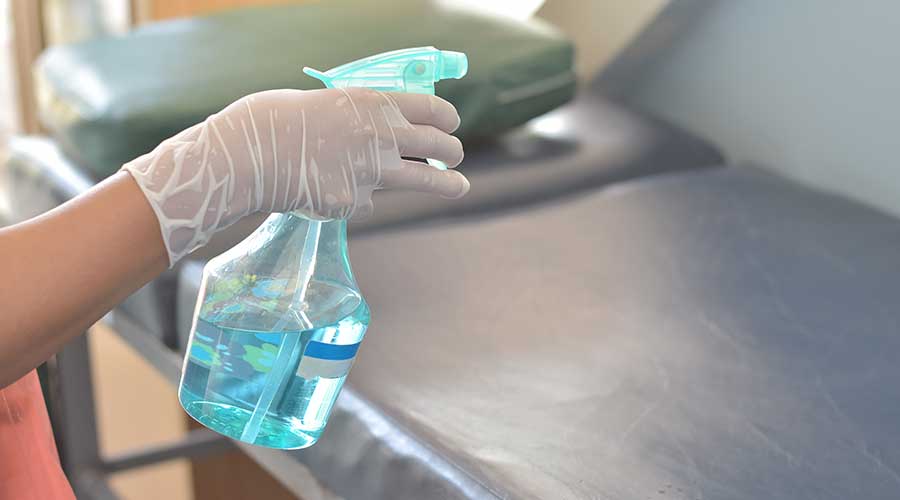Hospital cleaning is a complex system. There will always be some resource that is absent, and when additional cleaning is required, there are often insufficient resources available.
That is why on any given day, not everything scheduled to be cleaned will be cleaned. Increased hospital throughput and occupancy means that the number of surfaces to be decontaminated and made ready for the next patient has increased. With that increase in surfaces to be disinfected comes a corresponding increase in time pressure.
Patient room cleaning rates are much lower when the patient or visitor is present in the room. If patients are sitting in a chair near the bed, then environmental services (EVS) workers can clean the bed’s high-touch surfaces, such as the bedrails and bed controls. But if patients are in the bed, workers have to skip cleaning the bed and focus on cleaning the restroom.
Cleaning has poor and delayed feedback loops. In addition, visible cleanliness is an inadequate indicator of the presence of soil or microbes. For too long, clean has been a subjective term determined by a simple visual assessment. Two people inspecting the same room or the same object might have a different opinion about whether it passes the test.
The fact is that surfaces appearing to be clean might not actually be clean when scientifically quantified or qualified. Remember, what you cannot see can hurt you. You should be striving for health-based or hygienic cleaning, which is cleaning for healthier environments and not just for appearances.
In the absence of direct evidence, it is difficult to identify whether inadequate cleaning was due to:
- the wide range of surfaces needing to cleaned or disinfected
- a lack of education and easily understood training for housekeepers whose first language is not English
- the method of applying cleaners and disinfectants, including a spray bottle vs. a bucket or a mop and bucket vs. a microfiber mop
- not enough time allowed for thorough cleaning
- cleaners using the wrong tools, including cotton rags vs. microfiber
- no formal program for testing cleaning efficacy
- a failure of process, such as a flawed cleaning protocol
- a failure to follow process, meaning the process was poorly performed
- ambiguity over who cleans what in patient rooms
- poorly designed or ineffective checklists
- cluttered patient rooms impeding cleaning
Cleaning patient rooms is more efficient when workers follow a set pattern, whether it is cleaning from top to bottom or clockwise, rather than their own pattern. Environmental service workers are always dealing with interruptions, which increase the worker’s duration of cleaning.
Next-patient-room cross-transmission provides evidence of inadequate decontamination, including disinfection. But this phenomenon was identified when the prior occupant was known to be colonized or infected. This could be a failure of the wrong disinfectant, failure of the process or any one of the eight other reasons mentioned above.
Environmental services managers need to understand the dynamics of getting the job done with the workforce, retaining the best workers and building a team that delivers daily. At the end of the day, the building must be safe, clean and disinfected.
J. Darrel Hicks, BA, MESRE, CHESP, Certificate of Mastery in Infection Prevention is the Past President of the Healthcare Surfaces Institute. Hicks is nationally recognized as a subject matter expert in infection prevention and control as it relates to cleaning. He is the owner/principal of Safe, Clean and Disinfected. His enterprise specializes in B2B consulting, webinar presentations, seminars and facility consulting services related to cleaning and disinfection. Learn more at www.darrelhicks.com.

 Strategies to Eradicate Biofilm Containing C. Auris
Strategies to Eradicate Biofilm Containing C. Auris Man Attacks Nurses, Police Officer at Jefferson Hospital
Man Attacks Nurses, Police Officer at Jefferson Hospital Freeman Health System Breaks Ground on New Full-Service Hospital
Freeman Health System Breaks Ground on New Full-Service Hospital All Eyes on Gen Z as They Enter the Workforce
All Eyes on Gen Z as They Enter the Workforce Cleveland Clinic Starts Fundraising Effort for New Hospital in West Palm Beach
Cleveland Clinic Starts Fundraising Effort for New Hospital in West Palm Beach